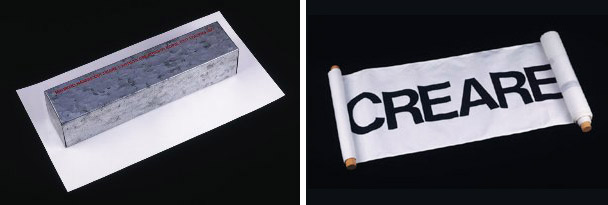
Creare l’artista creativo, Maurizio Nannucci, 1977. White cotton fabric scroll encased in a galvanized steel box, 29 x 238 cm. The Getty Research Institute, 890164, box 201 © Maurizio Nannucci
Saturday is the final day for the Santa Monica Museum of Art’s exhibition Libro/Oggetto: Italian Artists’ Books, 1960s–Now, a look at Italian artists’ books from the main art movements and trends of the second half of the 20th century. It includes materials from Italian and local institutions—including Arte Povera and Transavanguardia artists’ books from the special collections of the Getty Research Institute.
The Research Institute has quite an interesting collection of Italian artists’ books, in fact, and here are a few highlights.
Among the earliest works in the collection are Futurist metallic books produced in the early 1930s in a food-packaging company called Lito-Latta (i.e., litho-tin, or lithography printed on tin) in Savona, Liguria: Marinetti’s Parole in libertà futuriste olfattive tattili termiche (Words in Futurist, Olfactory, Tactile, Thermal Freedom) from 1932, and Tullio d’Albisola’s L’Anguria lirica, poema passionale (The Lyrical Watermelon: A Long, Passionate Poem) from 1933.
We also have the literal nuts and bolts of Futurist books: A hardware-bound book by Fortunato Depero from 1913–27 called Depero futurista (Depero the Futurist). Depero chose this binding technique to challenge the traditional book format.
The Futurists greatly influenced following generations of artists with their innovative use of media, as well as their creative experimentation with typography and graphic layouts, a style they called parole in libertà (words in freedom). Various Italian artistic groups adopted the use of diverse support media: paper would be replaced by metal, wood, plastic, fabric, and even stone.
Metal was chosen, for example, by visual poet Lamberto Pignotti for his 1975 book Il Mondo (The World), which consists of four “pages” of anodized iron plates. The imagery on these plates draws directly from the visual culture of mass media, featuring four rebuses published in the Roman newspaper Paese Sera, re-purposed with the term “the world” in Italian, French, English, and German (Il Mondo, Le Monde, The World, and Die Welt). The artist here expressed the idea that the world, in its complex diversity and multiplicity of languages, is a rebus without a solution.


Il mondo, Lamberto Pignotti, 1975. Plates of anodized steel held together with 2 anodized steel cylinders, each plate 16 x 17 cm. The Getty Research Institute, 2655-951 © Lamberto Pignotti

Piove, Mirella Bentivoglio. Two clear plastic sheets in a clear pastic base, 35.6 x 19 cm. The Getty Research Institute, 890164, box 126 © Mirella Bentivoglio
The new language of experimental typography and graphic layouts was also explored by several Italian artists working in the traditions of visual poetry and conceptual art.
At the GRI, these are best represented by Mirella Bentivoglio, whose works include Love Story and the multiple Piove (It’s Raining), and by Maurizio Nannucci’s conceptual objects such as Creare l’Artista Creativo (To Create the Creative Artist), printed on scroll, and Medium is Word, in which the term word is viewed through a kaleidoscope.
You can learn about these and see several more artists’ books in the finding aid for the art objects in the Jean Brown collection.

Books by Maurizio Nannucci. Top: Medium is word, 1975. Keleidoscope in a wooden box with a sliding top, 32 x 8 cm. Bottom: Museum of Modern Art, no. 15/30, 1983. Keychain inside a wooden box featuring a floor plan for a Museum of Modern Art, 7.3 x 10.8 cm. The Getty Research Institute, 890164, box 201 © Maurizio Nannucci
Most of the Italian artists’ books at the GRI are part of the Jean Brown collection, as well as the archives of art critics Wilhelm Arntz and Leonardo Borgese. A smaller, cohesive collection on Italian visual poetry was assembled by Luigi Ballerini. Many other Italian artists’ books came to GRI as individual donations or purchases and include works by Lucio Fontana, Piero Manzoni, and Enrico Baj. These books attest to the creativity and active involvement of these artists in international artistic debates and the art scene.

See all posts in this series »




Comments on this post are now closed.